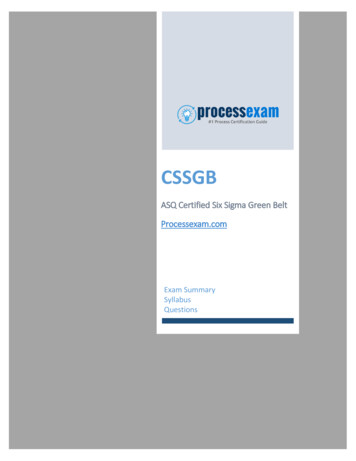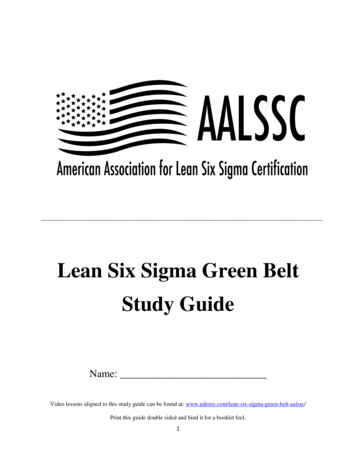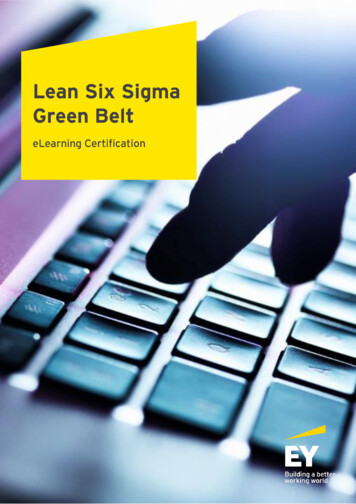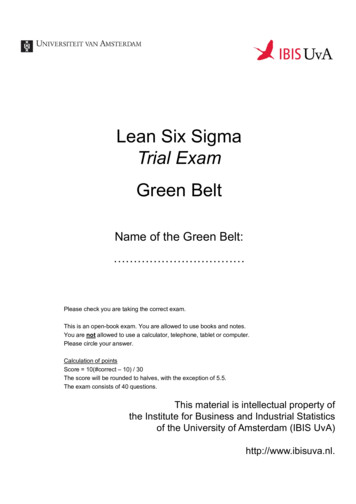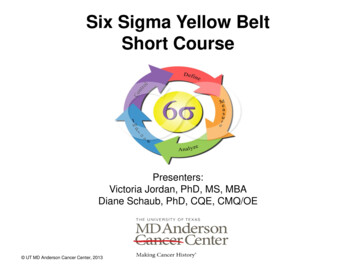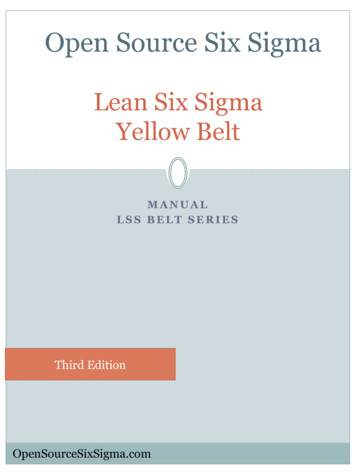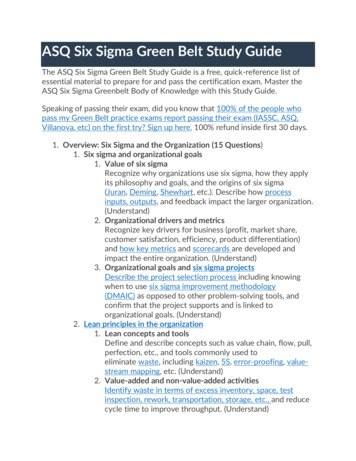
Transcription
ASQ Six Sigma Green Belt Study GuideThe ASQ Six Sigma Green Belt Study Guide is a free, quick-reference list ofessential material to prepare for and pass the certification exam. Master theASQ Six Sigma Greenbelt Body of Knowledge with this Study Guide.Speaking of passing their exam, did you know that 100% of the people whopass my Green Belt practice exams report passing their exam (IASSC, ASQ,Villanova, etc) on the first try? Sign up here. 100% refund inside first 30 days.1. Overview: Six Sigma and the Organization (15 Questions)1. Six sigma and organizational goals1. Value of six sigmaRecognize why organizations use six sigma, how they applyits philosophy and goals, and the origins of six sigma(Juran, Deming, Shewhart, etc.). Describe how processinputs, outputs, and feedback impact the larger organization.(Understand)2. Organizational drivers and metricsRecognize key drivers for business (profit, market share,customer satisfaction, efficiency, product differentiation)and how key metrics and scorecards are developed andimpact the entire organization. (Understand)3. Organizational goals and six sigma projectsDescribe the project selection process including knowingwhen to use six sigma improvement methodology(DMAIC) as opposed to other problem-solving tools, andconfirm that the project supports and is linked toorganizational goals. (Understand)2. Lean principles in the organization1. Lean concepts and toolsDefine and describe concepts such as value chain, flow, pull,perfection, etc., and tools commonly used toeliminate waste, including kaizen, 5S, error-proofing, valuestream mapping, etc. (Understand)2. Value-added and non-value-added activitiesIdentify waste in terms of excess inventory, space, testinspection, rework, transportation, storage, etc., and reducecycle time to improve throughput. (Understand)
3. Theory of constraintsDescribe the theory of constraints. (Understand)3. Design for Six Sigma (DFSS) in the organization1. Quality function deployment (QFD)Describe how QFD fits into the overall DFSS process.(Understand) (Note: the application of QFD is covered inII.A.6.)2. Design and process failure mode and effects analysis(DFMEA & PFMEA)Define and distinguish between design FMEA (DFMEA) andprocess (PFMEA) and interpret associated data. (Analyze)(Note: the application of FMEA is covered in II.D.2.)3. Road maps for DFSSDescribe and distinguish between DMADV (define, measure,analyze, design, verify) and IDOV (identify, design, optimize,verify), identify how they relate to DMAIC and how theyhelp close the loop on improving the end product/processduring the design (DFSS) phase. (Understand)2. Six Sigma – Define (25 Questions)1. Process Management for Projects1. Process elementsDefine and describe process components and boundaries.Recognize how processes cross various functional areas andthe challenges that result for process improvement efforts.(Analyze)2. Owners and stakeholdersIdentify process owners, internal and external customers,and other stakeholders in a project. (Apply)3. Identify customersIdentify and classify internal and external customers asapplicable to a particular project, and show how projectsimpact customers. (Apply)4. Collect customer dataUse various methods to collect customer feedback (e.g.,surveys, focus groups, interviews, observation) and identifythe key elements that make these tools effective. Reviewsurvey questions to eliminate bias, vagueness, etc. (Apply)5. Analyze customer dataUse graphical, statistical, and qualitative tools to analyzecustomer feedback. (Analyze)
6. Translate customer requirementsAssist in translating customer feedback into project goalsand objectives, including critical to quality (CTQ)attributes and requirements statements. Use voice of thecustomer analysis tools such as quality function deployment(QFD) to translate customer requirements into performancemeasures. (Apply)2. Project management basics1. Project charter and problem statementDefine and describe elements of a project charter anddevelop a problem statement, including baseline andimprovement goals. (Apply)2. Project scopeAssist with the development of project definition/scopeusing Pareto charts, process maps, etc. (Apply)3. Project metricsAssist with the development of primary and consequentialmetrics (e.g., quality, cycle time, cost) and establish keyproject metrics that relate to the voice of the customer.(Apply)4. Project planning toolsUse project tools such as Gantt charts, critical path method(CPM), and program evaluation and review technique (PERT)charts, etc. (Apply)5. Project documentationProvide input and select the proper vehicle for presentingproject documentation (e.g., spreadsheet output,storyboards, etc.) at phase reviews, management reviewsand other presentations. (Apply)6. Project risk analysisDescribe the purpose and benefit of project risk analysis,including resources, financials, impact on customers andother stakeholders, etc. (Understand)7. Project closureDescribe the objectives achieved and apply the lessonslearned to identify additional opportunities. (Apply)3. Management and planning toolsDefine, select, and use 1) affinity diagrams, 2) interrelationshipdigraphs, 3) tree diagrams, 4) prioritization matrices, 5) matrix
diagrams, 6) process decision program (PDPC) charts, and7) activity network diagrams. (Apply)4. Business results for projects1. Process performanceCalculate process performance metrics such as defects perunit (DPU), rolled throughput yield (RTY), cost of poorquality (COPQ), defects per million opportunities (DPMO)sigma levels and process capability indices. Track processperformance measures to drive project decisions. (Analyze)2. Failure mode and effects analysis (FMEA)Define and describe failure mode and effects analysis(FMEA). Describe the purpose and use of scale criteria andcalculate the risk priority number (RPN). (Analyze)5. Team dynamics and performance1. Team stages and dynamics2. Define and describe the stages of team evolution, includingforming, storming, norming, performing, adjourning, andrecognition.1. Identify and help resolve negative dynamics such asoverbearing, dominant, or reluctant participants, theunquestioned acceptance of opinions as facts,groupthink, feuding, floundering, the rush toaccomplishment, attribution, discounts, plops,digressions, tangents, etc. (Understand)3. Six sigma and other team roles and responsibilitiesDescribe and define the roles and responsibilities ofparticipants on six sigma and other teams, including blackbelt, master black belt, green belt, champion, executive,coach, facilitator, team member, sponsor, process owner,etc. (Apply)4. Team toolsDefine and apply team tools such as brainstorming, nominalgroup technique, multi-voting, etc. (Apply)5. CommunicationUse effective and appropriate communication techniques fordifferent situations to overcome barriers to project success.(Apply) See team conflict and team dynamics.3. Six Sigma – Measure (30 Questions)1. Process analysis and documentation
1. Process modelingDevelop and review process maps, written procedures, workinstructions, flowcharts, etc. (Analyze)2. Process inputs and outputsIdentify process input variables and process output variables(SIPOC), and document their relationships through causeand effect diagrams, relational matrices, etc. (Analyze)2. Probability and statistics1. Drawing valid statistical conclusionsDistinguish between enumerative (descriptive) and analytical(inferential) studies, and distinguish between a populationparameter and a sample statistic. (Apply)2. Central limit theorem and sampling distribution of the meanDefine the central limit theorem and describe its significancein the application of inferential statistics for confidenceintervals, control charts, etc. (Apply)3. Basic probability conceptsDescribe and apply concepts such as independence,mutually exclusive, multiplication rules, etc. (Apply)3. Collecting and summarizing data1. Types of data and measurement scalesIdentify and classify continuous (variables) and discrete(attributes) data. Describe and define nominal, ordinal,interval, and ratio measurement scales. (Analyze)2. Data collection methodsDefine and apply methods for collecting data such as checksheets, coded data, etc. (Apply)3. Techniques for assuring data accuracy and integrityDefine and apply techniques such as random sampling,stratified sampling, sample homogeneity, etc. (Apply)4. Descriptive statisticsDefine, compute, and interpret measures of dispersionand central tendency, and construct and interpret frequencydistributions and cumulative frequency distributions.(Analyze)5. Graphical methodsDepict relationships by constructing, applying andinterpreting diagrams and charts such as stem-and-leafplots, box-and-whisker plots, run charts, scatterdiagrams, Pareto charts, etc. Depict distributions by
constructing, applying and interpreting diagrams suchas histograms, normal probability plots, etc. (Create)4. Probability distributionsDescribe and interpret normal, binomial, and Poisson, chisquare, Student’s t, and F distributions. (Apply)5. Measurement system analysisCalculate, analyze, and interpret measurement system capabilityusing repeatability and reproducibility (GR&R), measurementcorrelation, bias, linearity, percent agreement, andprecision/tolerance (P/T). (Evaluate)6. Process capability and performance1. Process capability studiesIdentify, describe, and apply the elements of designing andconducting process capability studies, including identifyingcharacteristics, identifying specifications andtolerances, developing sampling plans, and verifying stabilityand normality. (Evaluate)2. Process performance vs. specificationDistinguish between natural process limits and specificationlimits, and calculate process performance metrics such aspercent defective. (Evaluate)3. Process capability indicesDefine, select, and calculate Cp and Cpk, and assess processcapability. (Evaluate)4. Process performance indicesDefine, select, and calculate Pp, Ppk, Cpm, and assess processperformance. (Evaluate)5. Short-term vs. long-term capabilityDescribe the assumptions and conventions that areappropriate when only short-term data are collected andwhen only attributes data are available. Describe thechanges in relationships that occur when long-term data areused, and interpret the relationship between long- andshort-term capability as it relates to a 1.5 sigma shift.(Evaluate)6. Process capability for attributes dataCompute the sigma level for a process and describe itsrelationship to Ppk. (Apply)4. Six Sigma – Analyze (15 Questions)1. Exploratory data analysis
1. Multi-vari studiesCreate and interpret multi-vari studies to interpret thedifference between positional, cyclical, and temporalvariation; apply sampling plans to investigate the largestsources of variation. (Create)2. Simple linear correlation and regressionInterpret the correlation coefficient and determine itsstatistical significance (p-value); recognize the differencebetween correlation and causation. Interpret the linearregression equation and determine its statistical significance(p-value). Use regression models for estimation andprediction. (Evaluate)2. Hypothesis testing1. BasicsDefine and distinguish between statistical and practicalsignificance and apply tests for significance level, power,type I and type II errors. Determine appropriate sample sizefor various test. (Apply).2. Tests for means, variances, and proportionsDefine, compare, and contrast statistical and practicalsignificance. (Apply)3. Paired-comparison testsDefine and describe paired-comparison parametrichypothesis tests. (Understand)4. Single-factor analysis of variance (ANOVA)Define terms related to one-way ANOVAs and interprettheir results and data plots. (Apply)5. Chi squareDefine and interpret chi square and use it to determinestatistical significance. (Analyze)5. Six Sigma – Improve & Control (15 Questions)1. Design of experiments (DOE)1. Basic termsDefine and describe basic DOE terms such as independentand dependent variables, factors and levels, response,treatment, error, repetition, and replication. (Understand)2. Main effectsInterpret main effects and interaction plots. (Apply)2. Statistical process control (SPC)
1. Objectives and benefitsDescribe the objectives and benefits of SPC, includingcontrolling process performance, identifying special andcommon causes, etc. (Analyze)2. Rational subgroupingDefine and describe how rational subgrouping is used.(Understand)3. Selection and application of control chartsIdentify, select,construct, and apply the following types of control charts: XBar R, X Bar s, individuals and moving range (ImR / XmR),median (), p, np, c, and u. (Apply)4. Analysis of control chartsInterpret control charts and distinguish between commonand special causes using rules for determining statisticalcontrol. (Analyze)3. Implement and validate solutionsUse various improvement methods such as brainstorming, maineffects analysis, multi-vari studies, FMEA, measurement systemcapability re-analysis, and post-improvement capability analysis toidentify, implement, and validate solutions through F-test, t-test,etc . (Create)4. Control planAssist in developing a control plan to document and hold the gains,and assist in implementing controls and monitoring systems.(Apply)
Six Sigma – Define (25 Questions) 1. Process Management for Projects. 1. Process elements. Define and describe process components and boundaries. Recognize how processes cross various functional areas and the challenges that result for process improvement efforts. (Analyze) 2. Owners and stakeholders. Identify process owners, internal and external customers,

